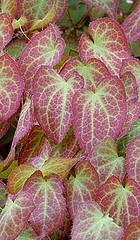 Also called bishop’s hat, red barrenwort an herbaceous rhizomaceous perennial and a member of the barberry family (Berberidaceae). It is a hybrid between E. alpinum and E. grandiflorum and is greatly valued as a groundcover especially under trees where it does well in shade and can compete with tree roots for water. Plants form clumps of compound medium green leaves with heart-shaped leaflets that are up to three inches long, pointed and toothed. They have a red tinge in the spring when they emerge before turning green in the summer, and then reddish in the fall. The flowers appear above the foliage on wiry stems in the spring and have red sepals and pale yellow petals. They are about one inch across and carried in loose racemes of fifteen to twenty. The flowers do not last well in the vase but the foliage is very valuable for flower arrangements especially when tinted red in the fall. It goes well with berries and other fall plant material. Although the foliage is beautiful in the spring it lasts only a few hours in the vase so should be allowed to remain on the plant.
Also called bishop’s hat, red barrenwort an herbaceous rhizomaceous perennial and a member of the barberry family (Berberidaceae). It is a hybrid between E. alpinum and E. grandiflorum and is greatly valued as a groundcover especially under trees where it does well in shade and can compete with tree roots for water. Plants form clumps of compound medium green leaves with heart-shaped leaflets that are up to three inches long, pointed and toothed. They have a red tinge in the spring when they emerge before turning green in the summer, and then reddish in the fall. The flowers appear above the foliage on wiry stems in the spring and have red sepals and pale yellow petals. They are about one inch across and carried in loose racemes of fifteen to twenty. The flowers do not last well in the vase but the foliage is very valuable for flower arrangements especially when tinted red in the fall. It goes well with berries and other fall plant material. Although the foliage is beautiful in the spring it lasts only a few hours in the vase so should be allowed to remain on the plant.
 Cutting: Cut foliage only in summer and fall.
Cutting: Cut foliage only in summer and fall.
Conditioning: Dip stems in boiling water for twenty seconds and then place in cold deep water for several hours. Flower stems can be treated the same way but don’t count on much longevity. Spring leaves should be submerged overnight in cold water but even with this treatment don’t expect much longevity.
Preserving: not relevant.
Cultivation:
-
Size: 6-8” H x 8” W
Light: Part shade
Soil: Average, medium moist, well-drained; somewhat drought tolerant once established
Hardiness: Zones 4-8
Propagation: Division in fall or after flowering
Care: Cut back old foliage in late winter or early spring.